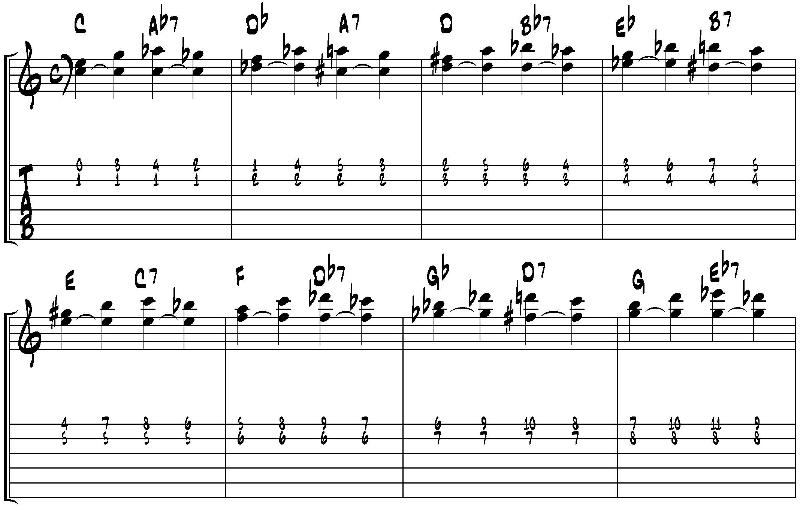|
By Scott Hesse  If you want to learn to improvise better in any style, you must understand how harmonies move. Over the course of the next two or three tips, I'm going to cover several different chord cycles. The aim is to help you internalize certain root movements in order to get more inside a given harmonic sequence. Once you're comfortable with certain tendencies of root movement, you can be free to reinvent the harmonies in different ways while improvising. The basic chord movement for almost any song is I-V-I. It is tension and resolution in its simplest form. What I've done in the example below is taken a series of 'I' chords that move to 'V' chords of the next key. The resolution chords ('I' chords) move up in minor second intervals and are preceded by their 'V' chord. This chord cycle is therefore known as the minor 2nd chord cycle. Seeing the root movement is important, but hearing the relationship is even more so. In order to really hear through the chord changes, I've written a particular harmonic/melodic pattern to use over the root movements. The pattern is the same throughout the key changes but modulates as the key centers move. I put the pattern on the top two strings, but this could be done on the G/B string set or the D/G string set as well. Be aware that if you start the pattern on the D/G string set that you may run out of room on your fretboard to complete the exercise. The Minor 2nd Chord Cycle: Once you get the basic harmonic/melodic pattern down, you might want to attempt the chord changes in a variety of places throughout the fret board. You can also use the chord progression itself as a template for playing the particular arpeggios. See if you can find this chord cycle in any tunes you're listening to now, or might know from the past.
Next time, we'll look at the Major 2nd chord cycle. Happy practicing!!
3 Comments
By Scott Hesse  Ok, for this last installment on intervallic picking exercises, we're going to really get in to it. The other three tips dealt with the exercise in its base form which is great as it is. Now I want to add even more application to this exercise. What I've written below is, sequentially, the intervallic picking exercise. Remember that I'm using three consecutive notes of the same interval. So you have three (ascending and descending) m2s in a row followed by three M2s followed by three m3s and so on. This next evolution adds another layer of notes to the existing pattern. In the first measure where you see m2s, I've taken the original three ascending minor m2nd intervals (C, C#, and D) and used them as starting points for a particular pattern. In this case, I use the interval of an ascending m2nd. I assign each of my original starting notes an ascending m2nd to come up with the new pattern you see in the first measure. Each of the ever-expanding interval choices is treated the same way resulting in one big pattern. This pattern can be broken into much smaller pieces for further study. I highly recommend it, as a matter of fact. Make sure to keep in mind that each one of these pattern-sets can be fit over a certain harmony.
For example, if I isolate the m6 set I get this note sequence: C, C#, Ab, A, E, F. As it is sequentially, it would sound great over a C13(b9), and FMaj7(#5), Dmin(Maj7), DbMaj7(#5), AMaj7(#5), Bm9(b5), etc. You can also tell this set is the inversion of the M3rd set. It's just a different way to approach it with bigger leaps. If you want to get those kinds of interval sounds in to your playing, you have to work on them. You have to hear them. Use this exercise to train yourself to hear what you want to hear. Happy practicing!! |
Guitar NotesHey, Friend! Welcome to Guitar Notes, practice tips and exercises for the progressing guitarist. I am passionate about music and all the possibilities for growth that come with an in-depth study of music. Even more, I am committed to sharing what I know to help YOU find a deeper awareness of your own possibilities as a musician. Here you will find a growing archive of the tips I send by email every other week. (Click the link below to sign up.) Archives
January 2016
|




 RSS Feed
RSS Feed